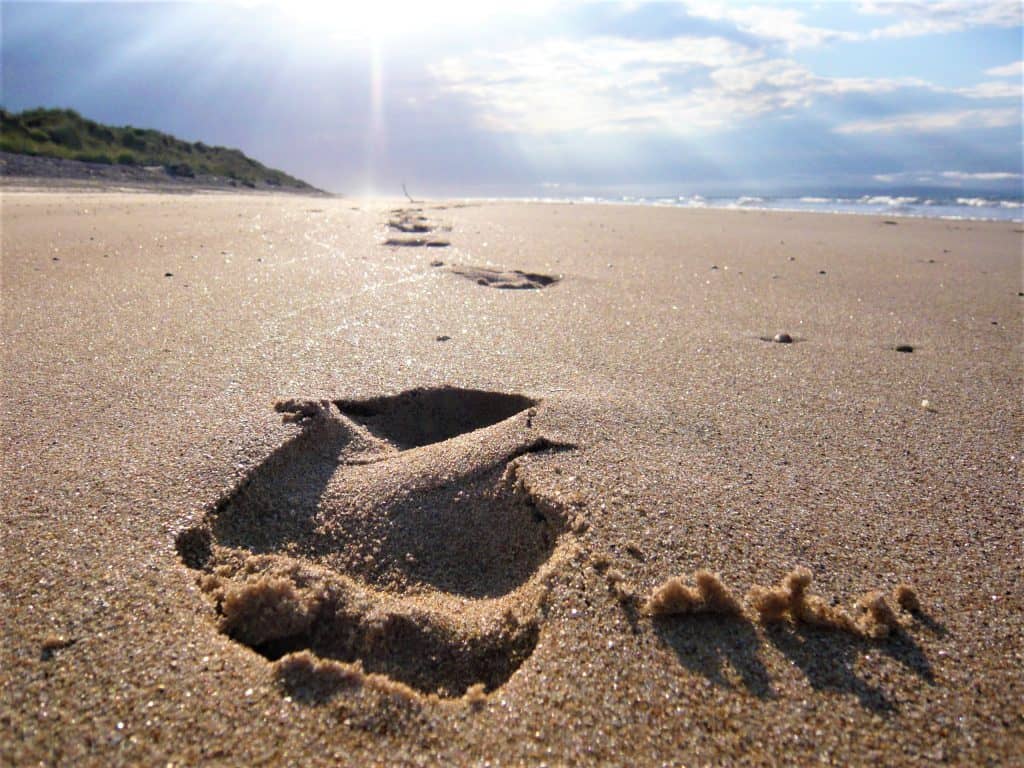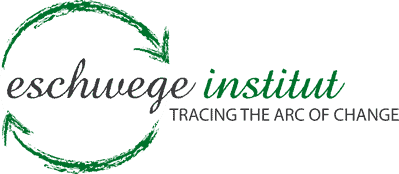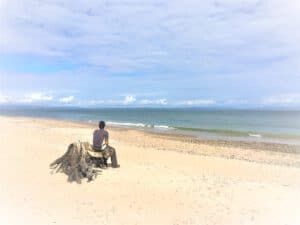
In the spirit of contemplative self-understanding, we take intuitive walks, also called threshold walks, and work with the mirror of nature. For this purpose, a symbolic ritual threshold is placed at an arbitrarily chosen location or something that is already there is said to represent a threshold. It doesn’t have to be more than a line in the sand, a branch or a garden gate. It has the same function as a door threshold through which one leaves or enters a room, only that in this case it supports a symbolic act and represents a ritual aid. We will come back to their meaning below.
First of all, we want to investigate what such intuitive walks are for, what the mirror of nature is all about and what exactly works in these processes.
Especially in times of personal upheaval and crisis-ridden phases, which usually go hand in hand with personal development processes and in which old self-images have to disintegrate, topics, but also solutions and unimagined potentials from the preconscious push into consciousness. In the topological model of Sigmund Freud’s human psyche, the preconscious lies between the subconscious and the conscious. Whatever pushes into consciousness from there, still eludes immediate access by consciousness. We cannot reflect on these messages because we are not yet aware of them. Many of us stand helpless at such times because our most well-trained tool for solving problems is the analytical mind. What the situation demands, however, is a non-cognitive practice of self-understanding.
For some, the only perceivable thing about these inner issues and potentials is this unsettling, unsettling and nameless urge. Many a growth crisis begins with this perception. An old equilibrium, an old self-satisfaction is gone and those affected now either live with the question of how to suppress this unsettling feeling or what it is exactly that is pushed so strongly into consciousness.
For those who are asking the latter question, working with Intuitive Walks and the Mirror of Nature is the ideal choice.
With the mirror of nature we start from the rule of thumb that, metaphorically speaking, our inner soul landscape is reflected in the outer landscape and that by observing this outer landscape we can learn more about what is inside of us or what inside of us is so itself.
We also assume that our entire inner landscape is shown in the mirror image of external reality, including our basic assumptions and those parts of our unconscious that are just pushing into consciousness. At the same time, a healthy internal economy ensures that only as much can be uncovered as we can handle. In this way we can symbolically recognize, examine or name the object of that inner urge and thus raise it into consciousness. Being able to name something has a calming effect in itself, which we typically call the „Rumpelstilzchen effect“. In the corresponding old German fairy tale, Rumpelstilzchen as a tormentor only has power over his victims for as long as they can not yet call him by name. As soon as we know the name of something, as soon as we can name the issues that are urging into consciousness, we have the power to continue to work with them consciously and in an integrative manner. Collecting important information for personal development from their waiting position in the preconscious and raising them into consciousness is one of the most important uses of the intuitive walks.
Intuitive walks are primarily undertaken in nature, preferably away from people and their settlements, because nature, in contrast to the social field, in which we withhold much out of caution or decency, does not know any moral evaluations and judgments. Nature has no “inhibitions” to honestly and unreservedly reflect topics such as sexuality, violence or death when they are brought into consciousness. This is particularly advantageous when it comes to personal weaknesses, blind spots or very vulnerable parts of us that we would not have let anyone else show us. In contrast to the social field, nature also represents the laws of a kind of irrefutable higher order, which also applies to our inner nature and of which it can remind us again and again in a self-ordering way.
What is working there?
What at first glance looks like too much esotericism makes a lot of sense from a perceptual psychological and neurological point of view. We perceive our world through individually different filters. Because these filters are based on our current emotional state, what we perceive says much more about us than about the objective world itself.
For this reason, a pregnant woman who is returning from shopping will probably report that she perceives that the baby boom is about to break out, because so many pregnant women are suddenly in the city. Of course, the real number of pregnant women has not increased, only the perception of the pregnant woman has increased, because she is completely fulfilled by this topic. There are also studies according to which predominantly people find a banknote on the floor who were in a positive mood at the time and believed such happiness to be possible.
The old Kabbalists (Jewish mystics) were probably right when they said that one cannot simply claim that the world is just the way it is. Rather, one has to say that the world is the way one is. One can never see anything other than oneself in one’s reality.
If we can accept that we humans tick as described in our perception, we can go a simple step further. The assumption is then that we can learn more about what is going on inside us if we simply pay closer attention to what we perceive in our external reality. This is exactly the basic principle of intuitive walks or threshold walks.
Figuratively speaking, we see the image of our inner soul landscape in the mirror of the outer landscape when we walk in the liminal field between the thresholds. Remaining in this figurative language, we can divide the inner soul landscape into different provinces.
We already know our way around the core province pretty well, which is why we compare it to our consciousness. It is surrounded by a huge area, which we call Terra Incognita, the unknown land of our soul, and which we can equate with our subconscious or with the preconscious. In addition, there are areas into which we have sometimes penetrated, but which we would voluntarily enter again for any money in this world. The impressions we had of ourselves there were too scary and too unacceptable for our self-image.
However, all these provinces are parts of us, only that our consciousness has not yet penetrated to all places within them. The unknown parts of our inner landscape, which belong to the subconscious or the preconscious, can by means of the contemplative Self-understanding in the mirror of nature to be consciously perceived and examined.
Leaving the familiar territory of the core province and crossing the border to the still unknown is in itself frightening. We have to take this fear seriously so that it does not begin to sabotage our endeavors for deeper self-understanding. In order to understand them, we have to bear in mind that real growth processes always take place at the limit where everything we knew about ourselves up to now ends and the terra incognita of our consciousness begins – the don’t know land.
In Fritz Perls’ Gestalt theory, this limit is called the “contact limit” and is compared to a theater stage. It’s exciting to get on stage and in front of the audience because we never know beforehand what it will be like and what will happen. The contact limit prompts one to risk something unpredictable and only partially controllable. The Gestalt theory states that personal growth and the feeling of real aliveness can only be experienced on this boundary. It is legitimate to hide behind the stage curtain for fear of the unpredictable, where it seems safe. Nothing can happen to us there – but nothing happens there either. With the decision to stay behind the curtain, we choose stagnation, because there no growth and no vitality can be experienced.
If we courageously decide for this “growing edge” of our personality and we follow the (monomythical) call into the unknown as we grow, we may expose ourselves again and again to the fear that comes with the unpredictable, but are rewarded with the experience of being alive and to be in the flow.
When looking in the mirror of nature we also have to do with the fear that we might find things during such mental self-examination that we would rather not know anything about and that could throw us off balance in such a way that we can no longer would be able to cope with everyday life. The more cautious and fearful part of us would like to prevent dealing with a new internal issue. He would rather go back to a homeostasis, which, however, is usually already lost.
The aid of the ritual threshold
In order to do justice to the just mentioned cautious aspect in us, we use the ritual aid of the threshold. With their help, we can make some kind of deal with that fearful part of us. We promise to stay behind this threshold only for a specified time. During this time we allow ourselves to allow that deeper awareness of ourselves. After that, we would return across the threshold, lock the door to this threshold world behind us, so to speak, and again display that healthy ignorance that we need to cope with our everyday lives. Most of the time, our fearful part gets involved in such a deal.
In this way, the ritual aid of the threshold helps to look into the mirror of nature with a more mindful perception for a manageable amount of time. It prevents the fearful part of us from trying to sabotage this by, for example, throwing thought bombs.
Guidelines for Intuitive Walks
For many, the focus on internal processes is unfamiliar, especially when they are supposed to perceive this internal nature in the mirror of the external. It is therefore necessary for success to refrain from as many forms of usual diversion as possible during a threshold walk. It takes practice and confidence in the procedure to calm the usual inner noises and digressions of the mind. This is another reason why we always cross the threshold alone.
Conversations with another person, or just their presence, would divert our focus from the subtle and mindful perception of the reality around us.
When we meet someone behind the threshold, we can choose to evade him * her, say hello or ask him * her a specific question, through which we accept him * her as part of nature’s mirror. It is important to only ask a single spontaneous question, to receive the answer and then not to engage in any further conversation, but to say thank you and move on.
If several threshold people are on the move at the same time, it is usually agreed in advance that one declares one another invisible and that it is in no way impolite to pass each other without a greeting. This is a gesture of respect for the possible depth of the process in which a counterpart might be.
Another common means of distraction is that of eating. Fasting makes it clear how much space this topic occupies in our lives. Food and other luxury foods are also known to be able to swallow, suppress and cover up something with them. This is unfavorable with a threshold walk – and not only here. That is why we fast while we are behind the threshold. What, on the other hand, is not only permitted, but essential is that you have enough drinking water with you.
Exposing ourselves to the elements of nature in such a way that we can also be touched by them is another core quality of the intuitive walk. Staying warm and dry is our health. In addition, we should not have so many protective layers around us that we no longer notice a faint wind or cannot hear the call of a bird because we sit in a tent or even in the car.
If we take a threshold walk on our own, we should let someone else know for safety reasons. We give her the approximate period of our absence and the area in which we want to be on the road, and arrange a short feedback when we are safely back.
How do I read nature’s mirror?
First of all, we shouldn’t hope to find another, somehow magical world behind the threshold. Everything that can change after crossing the threshold is the level of our mindfulness and the intensity of our perception.
It’s not about taking a particularly challenging or difficult path. It is also not necessary to cover long distances or to run all the time. Staying in places that attract us, even sleeping and dreaming there, can be important. The only thing that matters is to be open with all your senses to the beauty of life and the reality of death, as nature shows us both.
After a few meters, the attention of some threshold walkers falls on something that continues to captivate them all the time. Some pick up an item without knowing what it means and take it home with them, while others feel they have to return without a result, until they realize that they have been humming a song the whole time that they don’t like it, but the text contains exactly the information they were looking for.
This is what it takes: the assumption that really everything that happens behind the threshold has a deeper meaning and wants to communicate to us. That, beyond the desire to understand, we trust in attracting beings and forces of nature that give us symbolic references to our gifts and questions.
Some plan their threshold walk like a general staff and determine the exact route beforehand that they want to master in a precisely calculated time and in a well-known area. This is probably an attempt to keep control over the course of the business.
If we just work through a ready-made plan, it amounts to a walk through our core province. In it we would only find the answers that we already know. That can’t be the motivation to step over the threshold.
It is enough to pay just enough attention to the course of the path that we will find our way back later. Otherwise, you are invited to let yourself go. Instead of wanting to find or evoke something, it is more about being found, called and guided by something. As soon as something leads us away from the intended path and we have the courage to pursue it, we are already on an expedition to the Terra Incognita of our soul.
Is our attention for example attracted to a certain tree, we should be aware that this could have something to do with that 55 thousandth that the filters of our perception let through because it has something to do with us. We should investigate and see what the tree may have in store for us up close.
If we then look at it, we can translate the perception made with an aid that has to do with the old Chinese word for nature, “zi-ran”. Translated into English it would mean “Self so”or “it is so itself”. In keeping with our philosophical consideration that we can never see anything other than ourselves in our reality, the ancient Chinese understood the natural reality that surrounds them from the outset as something that is “so itself”.
If we find this tree intact at first glance, but then find that it is deeply wounded on the back, we can ask ourselves what corresponds to this symbolism in ourselves.
Perhaps our attention is drawn to an ant at the foot of this tree trying to drag something much too heavy through the soft sand up a hill. Again and again she slides down again shortly before her goal with the trickling sand, but, rationally speaking, she would have to try only a little further to the left, because there would not be this obstacle there.
If we now ask ourselves what is like this symbol in our life, then the insight could come that we are carrying things that are far too heavy in our lives and that it would be good to get an overview of alternative or lighter ones to be able to recognize ways. In the case of preconscious topics that push into consciousness, such a symbolic hint, a little nudge, is enough to drop the penny, so to speak.
Another method to understand more deeply and classify the experiences and perceptions from a threshold walk is the respectful feedback process of mirroring, which usually follows a threshold walk. In order to receive such a mirror on our experiences, we tell someone our experience report and then get it back from this person.
The art of mirroring consists in affirming and deepening without interpreting guru-like and mixing in one’s own.
This is an translated excerpt from the book “TRANCE UND CHANCE” by Holger Heiten, please do not use it without authorization


